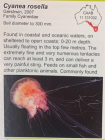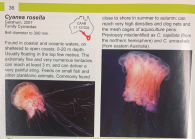WoRMS name details
Cyanea rosella Gershwin, 2008
1633565 (urn:lsid:marinespecies.org:taxname:1633565)
unaccepted > nomen nudum (not properly described)
Species
marine, brackish, fresh, terrestrial
recent only
Gowlett-Holmes K. (2008). A Field Guide to the Marine Invertebrates of South Australia. Notomares: Sandy Bay, Tasmania. 333 pp.
page(s): 36; note: Date is corrected from 2007 to 2008 (publication of the book). Species photo followed by brief description (reproduced here). Bell diameter to 300 mm. Found in coastal and oceanic waters, on shelte...
[details]
page(s): 36; note: Date is corrected from 2007 to 2008 (publication of the book). Species photo followed by brief description (reproduced here). Bell diameter to 300 mm. Found in coastal and oceanic waters, on shelte...
Date is corrected from 2007 to 2008 (publication of the book).
Species photo followed by brief description (reproduced here).
Bell diameter to 300 mm.
Found in coastal and oceanic waters, on sheltered to open coasts; 0-20 m depth.
Usually floating in the top few metres. The extremely fine and very numerous tentacles
can reach at least 3 m, and can deliver a very painful sting. Feeds on small fish and
other planktonic animals. Commonly found close to shore in summer to autumn; can
reach very high densities and clog nets and the mesh cages of aquaculture pens. Previously misidentified as C. capillata (from the northern hemisphere) and C. annaskala
(from eastern Australia).
Taxonomic remark This species appears only in a general field guide of marine invertebrates of South Australia (see reference).
The...
The...
Taxonomic remark This species appears only in a general field guide of marine invertebrates of South Australia (see reference).
The binomen is not valid. It is considered a nomen nudum because it does not meet two articles of the International Code of Zoological Nomenclature (ICZN, 1999) (viz. art. 13 and 16). [details]
The binomen is not valid. It is considered a nomen nudum because it does not meet two articles of the International Code of Zoological Nomenclature (ICZN, 1999) (viz. art. 13 and 16). [details]
WoRMS (2024). Cyanea rosella Gershwin, 2008. Accessed at: https://www.marinespecies.org/aphia.php?p=taxdetails&id=1633565 on 2024-11-21
![]() The webpage text is licensed under a Creative Commons Attribution 4.0 License
The webpage text is licensed under a Creative Commons Attribution 4.0 License
original description
Gowlett-Holmes K. (2008). A Field Guide to the Marine Invertebrates of South Australia. Notomares: Sandy Bay, Tasmania. 333 pp.
page(s): 36; note: Date is corrected from 2007 to 2008 (publication of the book). Species photo followed by brief description (reproduced here). Bell diameter to 300 mm. Found in coastal and oceanic waters, on shelte...
[details]
basis of record Gowlett-Holmes K. (2008). A Field Guide to the Marine Invertebrates of South Australia. Notomares: Sandy Bay, Tasmania. 333 pp. [details]
page(s): 36; note: Date is corrected from 2007 to 2008 (publication of the book). Species photo followed by brief description (reproduced here). Bell diameter to 300 mm. Found in coastal and oceanic waters, on shelte...
Date is corrected from 2007 to 2008 (publication of the book).
Species photo followed by brief description (reproduced here).
Bell diameter to 300 mm.
Found in coastal and oceanic waters, on sheltered to open coasts; 0-20 m depth.
Usually floating in the top few metres. The extremely fine and very numerous tentacles
can reach at least 3 m, and can deliver a very painful sting. Feeds on small fish and
other planktonic animals. Commonly found close to shore in summer to autumn; can
reach very high densities and clog nets and the mesh cages of aquaculture pens. Previously misidentified as C. capillata (from the northern hemisphere) and C. annaskala
(from eastern Australia).
basis of record Gowlett-Holmes K. (2008). A Field Guide to the Marine Invertebrates of South Australia. Notomares: Sandy Bay, Tasmania. 333 pp. [details]
From editor or global species database
Editor's comment Date is corrected from 2007 to 2008 (publication of the book).Species photo followed by brief description (reproduced here).
Bell diameter to 300 mm.
Found in coastal and oceanic waters, on sheltered to open coasts; 0-20 m depth.
Usually floating in the top few meters. The extremely fine and very numerous tentacles can reach at least 3 m, and can deliver a very painful sting. Feeds on small fish and other planktonic animals. Commonly found [details]
Taxonomic remark This species appears only in a general field guide of marine invertebrates of South Australia (see reference).
The binomen is not valid. It is considered a nomen nudum because it does not meet two articles of the International Code of Zoological Nomenclature (ICZN, 1999) (viz. art. 13 and 16). [details]

